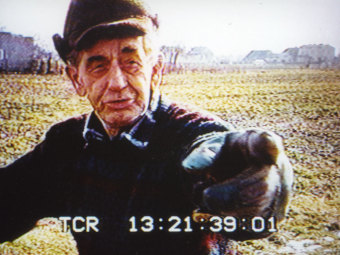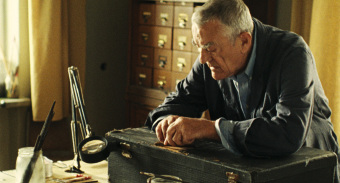Films about I.G. Farben and the Buna/Monowitz Concentration Camp

© Alfred Jungraithmayr

© 23/5, ZDF
“In acquainting us with the world we live in, the cinema exhibits phenomena whose appearance in the witness stand is of particular consequence. It brings us face to face with the things we dread. And it often challenges us to confront the real-life events it shows with the ideas we commonly entertain about them.”[1]
Film plays a major role in our process of grappling with social topics. While evidentiary value was ascribed in trials,[2] for example, to documentary films concerning the crimes of Nazi Germany, feature films on the Holocaust repeatedly had to face criticism of the way they dealt with history. The question of the extent to which the Holocaust can be represented is all the more apposite for film, as no shots from the concentration camps exist. The films shot by the Allies as documents date from the time after liberation. Reenactments are prohibited for moral and ethical reasons.
There are several cinematic approaches to the history of I.G. Farben and its plant and concentration camp at Auschwitz. They include both documentaries and feature films. It is striking that all refrain from showing images of the Buna/Monowitz concentration camp.
The feature film Der Rat der Götter (The Council of the Gods) (GDR, 1949/50, directed by Kurt Maetzig) attempts to give a portrait of I.G. Farbenindustrie AG and pillories the firm’s involvement in arms production in Germany between the wars, and the prevailing disregard for workers’ rights. The (fictional) four-part television series Väter und Söhne (Fathers and Sons) (FRG, 1984/85, directed by Bernhard Sinkel) follows two families (one German and Jewish, and one German and non-Jewish) over three decades on their interwoven path through German (chemical) history, shaped by I.G. Farben. Both films, made almost 40 years apart, are characterized by an attempt to come to grips with what happened; the great differences between the film narratives, however, are understandable in light of the political circumstances in which they were created.
The way Germans and Poles deal with the Auschwitz memorial site in present-day Poland is the subject of the feature film Am Ende kommen Touristen (And Along Come Tourists) (Germany, 2007, directed by Robert Thalheim).
The only film based on a literary source by a Buna/Monowitz survivor is La Tregua (The Truce) (Italy/France/Switzerland/Germany, 1996/97, in Italian with English subtitles, directed by Francesco Rosi), which takes its title from the novel (published in English as The Reawakening) by Primo Levi. The film, which shows the liberation of the character Primo from Buna/Monowitz and his subsequent long journey back to his home in Italy, employs tranquil images and a deliberately stylizing manner.
A second group of films adopts a documentary approach to the Buna/Monowitz concentration camp. It includes Monowitz. Ein Tatort (Monowitz: A Crime Scene) (Germany/Poland/Italy, 2002, directed by Alfred Jungraithmayr), in which an on-site search for traces is conducted in the Polish village of Monowice. In the British documentary film Satan at His Best (UK, 1995, directed by Maurice Hatton), former British POWs tell about their confinement in the E715 prisoner of war camp at Auschwitz and their encounters with the concentration camp inmates while doing forced labor for I.G. Auschwitz.
Escape from Auschwitz. A Portrait of Friendship (USA, 2001, directed by Josh Springer) deals with the successful escape of the friends Max Drimmer and Herman Shine from the Buna/Monowitz concentration camp and their subsequent time in the underground. The two mens’ stories are accompanied by the words of an expert, who places the statements in the context of oral history and indicates their significance. Another documentary film shows the efforts of former prisoners to receive compensation: I Was a Slave Labourer (Great Britain, 1999, directed by Luke Holland) follows the survivor Rudy Kennedy in his political struggle, 50 years after the war’s end, for acknowledgment and appropriate compensation for his sufferings, against a background of economic and political interests that are working in opposite directions.
(SP; Transl. KL)
















